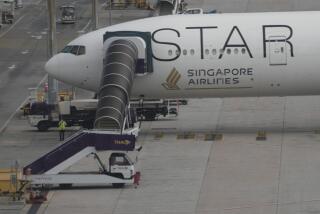Japan Jet Crash Investigators Hunt for Clues
TOKYO — Investigators combed the wreckage of a Taiwanese jetliner, questioned air traffic controllers and confiscated airline documents Wednesday in a search for clues to the cause of a crash at Nagoya airport that killed 262 people.
Questions about the Tuesday night crash of a China Airlines A300-600R Airbus focused on two issues: Why did the pilot try to abort his landing? And once he decided to make a second approach, why did the airplane lose power and crash about 200 yards short of the runway?
Two witnesses quoted on NHK television Wednesday said the aircraft’s approach was higher than usual, which could mean the pilot feared that he would overshoot the correct landing spot.
But control tower staff were quoted saying the height of the approach was normal. About 30 seconds before the crash, the pilot told air traffic control that he was aborting the landing and would circle around for a second try. That was his final communication.
The attempt at a sudden climb apparently caused engine trouble--either engine failure or explosions or both, according to witnesses and investigators. Speculation by Transportation Ministry officials and outside experts focused on the possibility that the jetliner’s sudden climb prevented at least one engine from getting enough air to keep running.
The airplane’s voice and flight recorders, which should shed further light on these questions, were recovered from the tangled wreckage, officials said. But analysis of that information will take days.
A young woman who had been pulled from the wreckage alive died in a hospital Wednesday afternoon, reducing the survivors to nine. Several other survivors remained in critical condition. The crash was the 10th-worst disaster in world commercial aviation history.
The Cabinet of outgoing Prime Minister Morihiro Hosokawa, which resigned en masse Monday to make way for the election of new Prime Minister Tsutomo Hata, is continuing to function in order to deal with the Airbus tragedy.
Transportation Minister Shigeru Ito said that among the questions the government wants answered is, “Why did the plane end up in such a disintegrated state?” One large section of fuselage remained intact, but the rest of the aircraft shattered into pieces.
The nine survivors had all been seated in the front of the cabin, said Hiroshi Fujiwara, former head of the Transportation Ministry’s Aircraft Accident Investigation Committee. This indicated that the tail of the airplane suffered the greater impact, he said.
A spokesman for the jetliner’s manufacturer, Airbus Industrie, said three engineers had left France for Nagoya to join the investigation.
Among the survivors were Yuji Nakayama, 6, and his brother Seiji, 3, both hospitalized in serious condition. Their mother and uncle died in the crash.
“It was nothing but a miracle,” Sadashige Kikuyama, a firefighter who pulled one of the boys from the burning wreck, told reporters. “He was caught under the plane’s tires. I just happened to hear this faint call of a boy saying, ‘Mama, Mama. It hurts.’ ”
More to Read
Sign up for Essential California
The most important California stories and recommendations in your inbox every morning.
You may occasionally receive promotional content from the Los Angeles Times.










